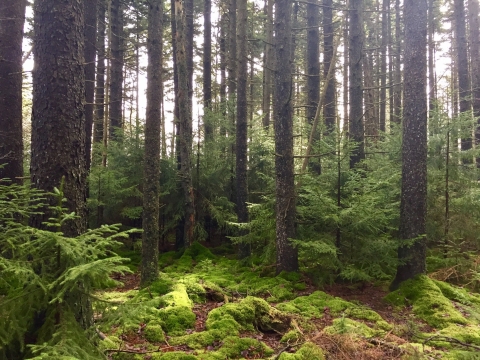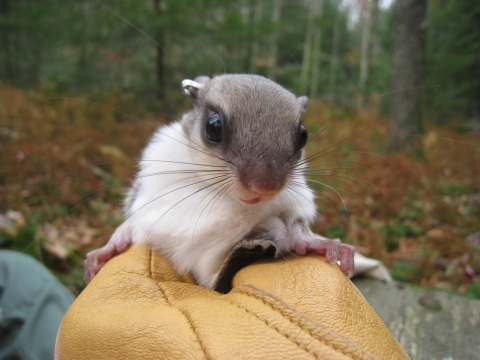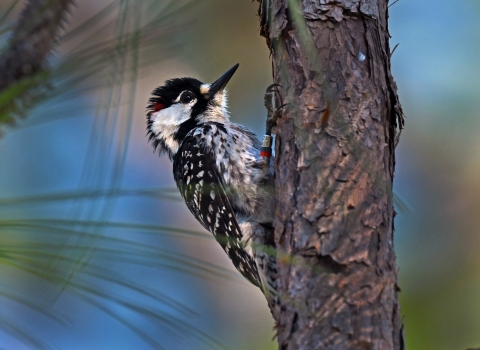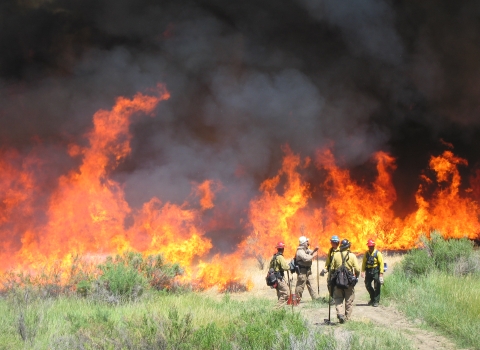Is the West Virginia northern flying squirrel poised to be America’s latest great species recovery story? A new report assessing the status of the squirrel in its first five years since coming off of the endangered species list indicates it is doing well and its habitat is expanding.
The squirrel — called the Virginia northern flying squirrel or more commonly the West Virginia northern flying squirrel — was listed as an endangered species in 1985. But restoration efforts helped the species rebound, and in 2013 the West Virginia northern flying squirrel joined an exclusive group of species to successfully be recovered and taken off the endangered list.
Since then, restoration work has continued and ramped up year after year. Partners working behind the scenes have many reasons to be optimistic about the future of this unique subspecies.
To Save a Species, Save Its Habitat
Survival of the squirrel depends on survival of its habitat — red spruce-northern hardwood forest, which consists of red spruce, fir, beech, yellow birch, sugar or red maple, hemlock and black cherry. It used to be that the iconic, high-elevation red spruce forest blanketed hundreds of thousands of acres of the Central Appalachians. But much of that was destroyed in the late 1800s and early 1900s due to logging and wildfire.
“This habitat is really special,” said Barb Douglas, U.S. Fish and Wildlife Service senior endangered species biologist. “There’s some old-growth left, but a lot of it was cut over at the turn of the 20th century.”
“If you go into a really old-growth spruce forest, it’s mossy and green and smells good,” added Laura Hill, a retired fish and wildlife biologist for the Service. “It’s surreal. It’s quiet, the ground is spongy and soft. It’s calming and soothing.”
In the decades preceding and following the listing of the West Virginia northern flying squirrel, protection and restoration efforts were able to bring the red spruce-northern hardwood forest habitat back to more than 173,000 acres in West Virginia.
And the work didn’t stop when the squirrel was taken off the endangered species list in 2013. In the following five years, more than 7,455 acres of West Virginia northern flying squirrel habitat has been created, protected or restored. Additionally, even without formal protection, federal biologists coordinated with project proponents to keep habitat loss at a negligible level of 285 acres — amounting to 26 times more habitat saved than lost.
As a result, the five-year report finds that the squirrel remains well distributed across all seven core areas and continues to be found at new, expanded and historical sites, with long-term potential for a slowly growing population, as hoped for.
“Since the time of delisting, we are still finding squirrels in the places we were finding them, and we’ve also found them in new locations, which reflects the improving conditions of the habitat,” Douglas said.
A Partnership Tale
This success is due entirely to a partnership — called the Central Appalachian Spruce Restoration Initiative or CASRI — of groups committed to restoration and protection efforts in the Central Appalachians. The CASRI partnership has grown from seven to 22 groups since it was created in 2007, with members ranging from Canaan Valley National Wildlife Refuge to the West Virginia Highlands Conservancy and USDA Natural Resources Conservation Service.
“The squirrel was really what crystallized restoration efforts in this region,” said Douglas.
Shane Jones, a wildlife biologist for the USDA Forest Service, noted that the squirrel’s status catalyzed a landscape-scale effort.
“The Endangered Species Act drew attention to the red spruce habitat used by the squirrel,” Jones said. “The Fish and Wildlife Service, Forest Service and The Nature Conservancy saw that energy, and instead of delisting and moving on, they used that energy to sign an MOU [memorandum of understanding] that later evolved to the group known as CASRI.”
Partners are motivated to restore red spruce for many reasons, whether it’s for the conservation of the flying squirrel or Cheat Mountain salamander, or because the soil in red spruce forests can trap more carbon from the atmosphere than hardwood, or because it stores significant amounts of water that ease flooding and drought. Or perhaps simply because red spruce and the wildlife that call it home are part of what makes West Virginia wild and wonderful.
The partnership focuses on planting spruce trees, helping red spruce reach advanced age more quickly, and increasing forest patch sizes and connectivity. The Nature Conservancy is one leader in reforestation, and has engaged in land purchases of key habitat from willing sellers in the region.
“I’m very proud of the work this partnership has done,” said Ben Rhodes, ecological restoration coordinator for The Nature Conservancy in West Virginia. “Every single organization in CASRI has played an integral role.”
This time of year, Rhodes and his team are busy preparing for the spring planting season. They’re getting seedlings lined up and are on target to plant 70,000 red spruce and 65,000 northern hardwoods. It’s more than last year, he noted, and every year it’s been more.
“Ten years ago we were planting about 30,000 trees and now we’re planting 135,000,” he said. “It’s because we have this strong, partnership-based collaborative effort.”
According to Rhodes, it used to be hard to get these seedlings. Norway spruce is similar and widely available, but it’s non-native and not an ideal substitute for red spruce. Through CASRI, partners have been able to collect red spruce seeds locally that are then grown in a greenhouse and brought back to be planted as seedlings.
“This is all due to the partnership,” he said. “And now we have enough that we can work on increasing the genetic diversity of our seeds, to maximize their resilience to climate change climate change
Climate change includes both global warming driven by human-induced emissions of greenhouse gases and the resulting large-scale shifts in weather patterns. Though there have been previous periods of climatic change, since the mid-20th century humans have had an unprecedented impact on Earth's climate system and caused change on a global scale.
Learn more about climate change .”
Climate change is a wildcard for the squirrel and its habitat. Red spruce are highly vulnerable to drought, which is predicted to grow across the region as temperatures warm. But Rhodes noted that all the positive work — from the CASRI restoration partnership and large quantity of seedlings being planted to the fact that air pollution has greatly decreased in the region due to the Clean Air Act — might hopefully balance out the negative impacts of climate change.
“We’re not sure how all these positives and negatives will play out,” he acknowledged, “but we’re hopeful.”
“Delisting Is Not the End of the Story”
Much of the work has happened in West Virginia’s Monongahela National Forest, which provides the majority of the squirrel’s habitat. The Forest Service has committed to making progress toward long-term forest goals that support the West Virginia northern flying squirrel.
They are already meeting the upper end of their interim objectives and are undertaking some innovative approaches to restore large tracts of degraded lands that were once coal mine sites.
“They developed a whole new technique on how to restore that habitat,” Hill said.
This work is turning former mining sites into forests of red spruce and other native vegetation, with wetlands to restore hydrology. This meant working with abandoned mineland folks, the Office of Surface Mining and other non-traditional partners.
“It’s become such a part of our doctrine that whenever we go to an area from a planning perspective we ask, ‘What do we have here for spruce?’” Jones said.
With partners exceeding their restoration goals in the first five years following delisting, the future does look brighter than ever for the West Virginia northern flying squirrel. West Virginia Division of Natural Resources (DNR) has been monitoring the squirrel since 1985, using nest box checks, live captures, radio-telemetry and, most recently, acoustics. As time has gone on, they have adapted their methods to reflect changing needs and to incorporate new technologies.
“The long-term monitoring program has been crucial to our understanding of the recovery of the species,” said Jack Wallace, a Rare, Threatened, and Endangered Species biologist with the West Virginia DNR. “Without the long-term data, it would have been hard to be confident in the direction and reliability of the population increase.”
“This really shows that delisting a recovered species is not the end of the story,” said Douglas. “In this case, partnership-based efforts are strong and the forest habitat should continue to expand. The U.S. Fish and Wildlife Service is committed to working with partners to ensure that recovered wildlife populations stay healthy, even after removal as a threatened or endangered species.”
There will be another report in five years that monitors a decade of work since removal from the endangered species list.
“It is kind of cool going back to early spruce planting sites, and they aren’t just little baby trees anymore — you’ve got a forest now,” said Douglas. “This certainly gives me hope.”









